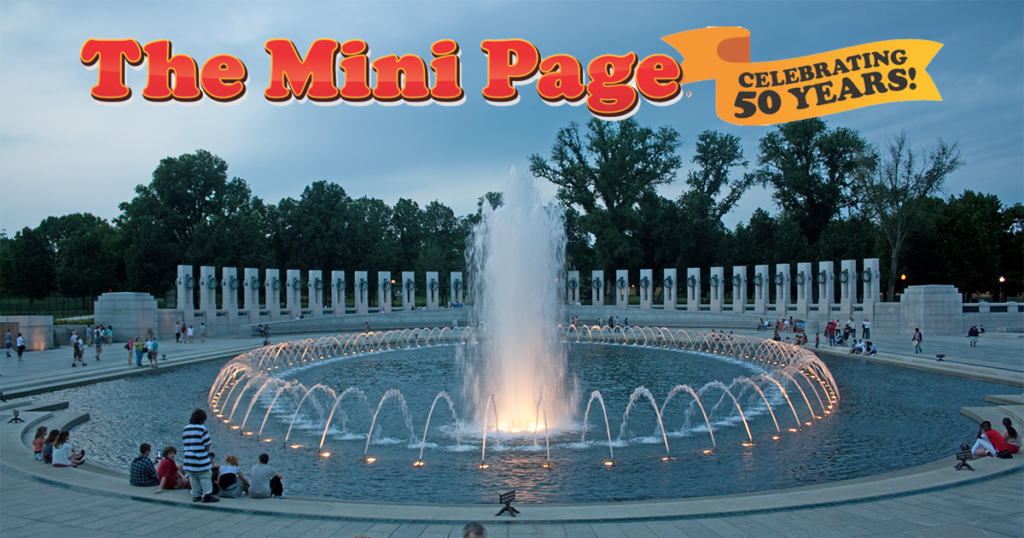
AMP | Kids is proud to announce an ongoing partnership with The Mini Page, now in its 50th year of providing engaging and fun learning opportunities to young readers across the country. This feature was originally syndicated in newspapers the week of May 18 – 24, 2019. It is distributed digitally here with permission from Andrews McMeel Syndication. Enjoy and share with the young learners in your life!
Fifteen years ago, a new memorial was dedicated in Washington, D.C. Since then, millions of visitors have walked through the memorial and paid tribute to the men and women who served in World War II, which lasted from 1939 to 1945.
In honor of Memorial Day on May 27, The Mini Page visits the National World War II Memorial.
World War II
The Second World War ended almost 75 years ago. You may have great-grandparents who helped our country fight its way to victory.
Franklin Roosevelt was president during most of World War II. Harry S. Truman took over when Roosevelt died in 1945. He was president when the war ended.

Courtesy of Wikipedia Commons
The United States did not enter the war until 1941, when Japan attacked Pearl Harbor in Hawaii, a U.S. base for the Navy. Roosevelt called Dec. 7, 1941, “a date which will live in infamy,” and Congress declared war on Dec. 8.
Americans fought World War II in two main theaters, or regions, which came to be known as the Atlantic and Pacific. More than 30 countries eventually were involved in the war.
The memorial
- The two arches stand for the Atlantic andPacific regions.
- At the time of World War II, there were 48 states, seven territories and the District of Columbia. The memorial has 56 pillars, each one with the name of the state or territory and bronze oak and wheat wreaths.
- Twenty-four panels made of bronze line the entrance to the memorial. These show scenes from the war, including soldiers getting medical exams and coming home from the war.
- The Rainbow Pool is at the center of the memorial.
- The memorial lies on the National Mall between the Washington Monument and the Lincoln Memorial.

Courtesy of Flickr
The war effort
Civilians, or people who were not serving in the armed forces, were much more involved in the war effort than people are today. Many families had victory gardens, where they grew vegetables to eat so that other food could be sent to the troops.
Kids felt strongly about recycling. Many did their part to help the war effort by collecting scrap materials to be used in making weapons and machines.
In some cities, there were blackouts so light would not guide enemy planes or submarines to targets. People would draw heavy blackout shades across their windows at night to keep light inside.
Families were encouraged to read the newspaper and listen to the radio for news of the war. They were discouraged from spreading false rumors.
Rationing
Many items were scarce because they were needed in the war effort or because they had to be shipped to our allies, or countries who were fighting on our side.
Rationing, or distributing items equally, was an effort to give everyone a fair share of scarce goods and keep prices low. The rationed items included gas, coffee, sugar, rubber, beef, oils and some canned foods.
Resources:
On the web: National Park Service, World War II Memorial
At the library: “Voices From the Second World War: Stories of War as Told to Children of Today” (Candlewick Press)
Teachers: For standards-based activities to accompany this feature, visit Andrews McMeel Syndication. And follow The Mini Page on Facebook!
